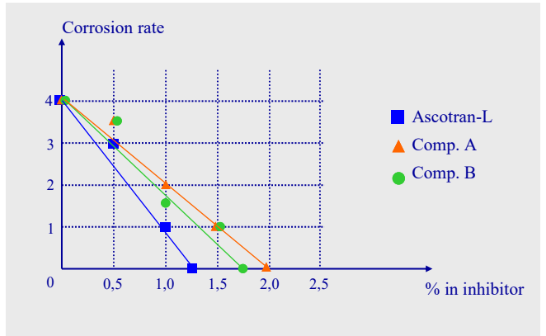Enhanced TDS
Identification & Functionality
- Carrier
- Chemical Family
- Chemical Name
- CASE Ingredients Functions
- Cleaning Ingredients Functions
- Fluids & Lubricants Functions
- Technologies
- Product Families
- Chemical Nature
Aqueous preparation made of organic acid salts and azole derivatives.
Features & Benefits
- Labeling Claims
- Fluids & Lubricants Features
- HII Features
- Product Features
- Added to metal working solutions, it also protects metals during short or long immersion periods.
- Fully water-soluble liquid, safe to apply.
- Protects ferrous and non-ferrous metals.
- Prevents flash corrosion on steel.
- Forms a hydrophobic film on the metal surface, which can be coated over with conventional paint systems.
- Free of bore, phosphate, molybdate, silicate or nitrite.
- Exclusively made of authorized substances for food-contact cleaners (according to decree of 08/09/99).
- Meets PMUC standard requirements.
Applications & Uses
- Markets
- Applications
- Compatible Substrates & Surfaces
- Fluids & Lubricants Type
- Fluids & Lubricants End Use
- Home Care Applications
- I&I Cleaning Applications
- Use Level
- 2 - 15% (Temporary Protection), 0.05 - 0.2% (Hydrostatic Tests), 0.7 to 2% (Other Applications)
- Typical Application
Mainly used for:
- Synthetic or semi-synthetic hydrosoluble lubricants and metal working fluids
- Hydrosoluble hydraulic fluids
- Coolants or anti-freezes.
- Temporary protection of metal equipment or components
- during transport and dry storage.
- Protection from flash corrosion during hydro blasting.
- Protection of metal equipment during hydrostatic test procedures.
- Protection of metal equipment in long-term contact with a static aqueous solution: pipes during inactivity periods, tanks, and containers.
Can also be used in :
- Other solutions for metal machining (degreasing, stripping, polishing, cleansing under pressure).
- Neutral-to-alkaline detergents.
- Product Application
The pH of the end solution needs to be above 7 for an optimal efficiency.
Metalworking fluids
The Ascotran-L is added into water-soluble lubricants concentrates or ready-to-use solutions to get a final dosage of 50 to 5000 ppm, depending on the formulation, its pH, and the metal nature to protect.
Temporary protection
The Ascotran-L can be applied by spraying, dipping after being diluted into water, or inside the last metal working bath (washers, rinsing tanks). Dosage from 2 to 15% depending on the required protection duration.
Hydrostatic tests
The Ascotran-L is diluted into the water used for the test, at a dosage between 0.05 and 0.2% depending on the metals to protect and the test duration.
Other applications
The Ascotran-L is mixed into water-based solutions at a dosage between 0.7 to 2% depending on the solution nature and metals to protect.
Properties
- Physical Form
- Soluble In
- Appearance
- Yellow to amber limpid liquid
- Stable in
- Hard Water
- Immiscible In
- Isopropanol, White-Spirit
- Miscible in
- Water, Ethanol, Glycols, Acetone (up to 20%)
- Soluble in
- Water
- Typical Properties
Value Units Test Method / Conditions Density (at 20°C) 1.11 - 1.15 - - Viscosity (at 20°C) 600 - 800 cPs - pH Pure (at 20°C) 8.4 - 9 - - Freezing Point max. 0 °C - Foaming Power Very Low - -
Regulatory & Compliance
- Certifications & Compliance
- Chemical Inventories
Technical Details & Test Data
- Performance Data
Flash Corrosion Protection
Method: DIN 51360/part2
Performance in different media

A comparative study with competitors :
Medium : deionized water
Competitors A and B : liquid corrosion inhibitors

Protection against atmospheric corrosion
Method : climatic chamber, 25°C, 100% of humidity
Substrate : mild-steel immersed few minutes in tap-water containing the inhibitor.
Max exposure time without corrosion of the substrate% in Ascotran-L 0% 2% 5% 10% Test duration without corrosion on mild-steel <24h 100h 150h >200h
Protection during immersion
Minimal protection duration of metal specimens immersed into tap-water at room temperature :% in Ascotran-L 0 % 0.05% 0.10% 0.20% 0.30% Mild-steel <1d 1 week 1 week 18 m 36 m Aluminium 99% 3d 4m 4m 4m 12m Copper 99% 3d 9m 9m 36m 36m Brass 30d 36m 36m 36m 36m Method IP329: weight loss measurement of the metal specimens immersed into deionized water, at 45°C, during 4 months.
Specimens Independently :

Specimens Together (Galvanic Protection) :

Packaging & Availability
- Packaging Type
- Supplied by
- Packaging Information
- Plastic pail of 30kg net.
- Metal drum of 200kg net.
- IBC of 1000 kg net.
- Transport
No specific condition for transport. Weight and packaging size (off-pallet) :
- Pail : 1.5kg - Ø30, H50
- Drum : 15kg - Ø60, H90
IBC : 70kg - L120, l100, H120
Storage & Handling
- Shelf Life
- 2 Years
- Storage and Shelf Information
- Ideal temperature conditions: 0 to 30°C.
- Exposure: avoid direct exposure to sunlight.
- Expiration: 2 years in its original sealed drum, in the storage conditions described above. With time, the colour of the product may turn darker, but it does not modify its properties.
